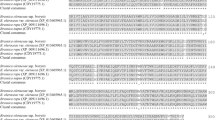Abstract
We report the cloning and characterization of two lectin genes from Medicago truncatula, designated Mtlec1 and Mtlec2. The two genes show a high degree of homology and apparently belong to a small multigene family. Mtlec1 appears to encode a functional lectin with 277 amino acids, whereas Mtlec2 is probably non-functional, since a frameshift mutation (insertion of two nucleotides) leads to premature translation termination after only 98 amino acids. The deduced amino acid sequence of the polypeptide MtLEC1 suggests that this lectin is a metalloprotein with Glc/Man specificity.
Similar content being viewed by others
References
Barker DG, Bianchi S, Blondon F, Dattée Y, Duc G, Essad S, Flament P, Gallusci P, Génier G, Guy P, Muel X, Tourneur J, Dénarié J, Huguet T: Medicago truncatula, a model plant for studying the molecular genetics of the Rhizobium-legume symbiosis. Plant Mol Biol Rep 8: 40–49 (1990).
Barker DG, Gallusci P, Lullien V, Khan H, Ghérardi M, Huguet T: Identification of two groups of leghemoglobin genes in alfalfa (Medicago sativa) and a study of their expression during root nodule development. Plant Mol Biol 11: 761–772 (1988).
Bohlool BB, Schmidt EL: Lectins: A possible basis for specificity in the Rhizobium-legume root nodule symbiosis. Science 185: 269–271 (1974).
Bourne Y, Abergel C, Cambillau C, Frey M, Rougé P, Fontecilla-Camps JC: X-ray crystal structure determination and refinement at 1.9 Å resolution of isolectin I from the seeds of Lathyrus ochrus. J Mol Biol 214: 571–584 (1990).
Bourne Y, Roussel A, Frey M, Rougé P, Fontecilla-Camps JC, Cambillau C: Three-dimensional structures of complexes of Lathyrus ochrus isolectin I with glucose and mannose: fine specificity of the monosaccharide-binding site. Proteins 8: 365–376 (1990).
Cunningham BA, Hemperly JJ, Hopp TP, Edelmann GM: Favin versus Concanavalin A: Circularly permuted amino acid sequences. Proc Natl Acad Sci USA 76: 3218–3222 (1979).
Díaz CL, Melchers LS, Hooykaas PJJ, Lugtenberg BJJ, Kijne JW: Root lectin as a determinant of host-plant specificity in the Rhizobium-legume symbiosis. Nature 338: 579–581 (1989).
van Driessche E: Structure and function of Leguminosae lectins. In: Franz H (ed) Advances in Lectin Research, vol. 1. Springer-Verlag, Berlin (1988).
Einspahr H, Parks EH, Suguna K, Subramanian E, Suddath FL: The crystal structure of pea lectin at 3.0 Å resolution. J Biol Chem 261: 16518–16527 (1986).
Etzler ME: Plant lectins: Molecular and biological aspects. Annu Rev Plant Physiol 36: 209–234 (1986).
Feinberg AP, Vogelstein B: A technique for radiolabelling DNA restriction endonuclease fragments to high specific activity. Anal Biochem 132: 6–13 (1983).
Gallusci P, Dedieu A, Journet EP, Huguet T, Barker DG: Synchronous expression of leghemoglobin genes in Medicago truncatula during nitrogen-fixing root nodule development and response to exogenously supplied nitrate. Plant Mol Biol 17: 335–349 (1991).
Gatehouse JA, Bown D, Evans IM, Gatehouse LN, Jobes D, Preston P, Croy RRD: Sequence of the seed lectin gene from pea (Pisum sativum L.). Nucl Acids Res 15: 7642 (1987).
Heidecker G, Messing J: Structural analysis of plant genes. Annu Rev Plant Physiol 37: 439–466 (1986).
Heijne Gvon: A new method for predicting signal sequence cleavage sites. Nucl Acids Res 14: 4683–4690 (1986).
Henikoff S: Unidirectional digestion with endonuclease III creates targeted breakpoints for DNA sequencing. Gene 28: 351–359 (1984).
Higgins TJV, Chandler PM, Zurawski G, Button SC, Spencer D: The biosynthesis and primary structure of pea seed lectin. J Biol Chem 258: 9544–9549 (1983).
Kamberger W: Binding specificity and purification of Medicago sativa lectin. In: Hoffmann-Ostenhof D (ed) Affinity Chromatography, pp. 295–298. Pergamon Press, Oxford (1978).
Konami I, Yamamoto K, Osawa T: The primary structure of the Lotus tetragonolobus lectin. FEBS Lett 268: 281–286 (1990).
Kraft R, Tardiff J, Krauter KS, Leinwand LA: Using mini-prep plasmid DNA for sequencing double stranded templates with SequenaseTM. BioTechniques 6: 544–547 (1988).
Lerouge P, Roche P, Faucher C, Mailet F, Truchet G, Promé JC, Dénarié J: Symbiotic host-specificity of Rhizobium meliloti is determined by a sulphated and acylated glycosamine oligosaccharide signal. Nature 344: 781–784 (1990).
Richardson M, Rougé P, Sousa-Cavada B, Yarwood A: The amino acid sequences of the α1 and α2 subunits of the isolectins from seeds of Lathyrus ochrus (L.). FEBS Lett 175: 76–81 (1984).
Ripley LS: Frameshift mutation: Determinants of specificity. Annu Rev Genet 24: 189–213 (1990).
Sharon N, Lis H: Lectins as cell recognition molecules. Science 246: 227–246 (1989).
Sharon N, Lis H: Legume lectins — A large family of homologous proteins. FASEB J 4: 3198–3208 (1990).
Strosberg AD, Buffard D, Lauwereys M, Foriers A: Legume lectins: A large family of homologous proteins. In: Liener IE, Sharon N, Goldstein IJ (eds) The Lectins: Properties, Functions and Applications in Biology and Medicine, pp. 249–264. Academic Press, Orlando, FL (1986).
Truchet G, Roche P, Lerouge P, Vasse J, Camut S, de Billy F, Promé J-C, Dénarié J: Sulphated lipo-oligosac-charide signals of Rhizobium meliloti elicit root nodule organogenesis in alfalfa. Nature 351: 670–673 (1991).
Vodkin LO, Rhodes PR, Goldberg RB: cA lectin gene insertion has the structural features of transposable element. Cell 34: 1023–1031 (1983).
Yarwood A, Richardson M, Sousa-Cavada B, Rougé P: The complete amino acid sequences of the β1 and β2 subunits of the isolectins LoLI and LoLII from seeds of Lathyrus ochrus (L.). FEBS Lett 184: 104–109 (1985).
Young NM, Johnston RAZ, Watson DC: The amino acid sequence of peanut agglutinin. Eur J Biochem 196: 631–637 (1991).
Author information
Authors and Affiliations
Rights and permissions
About this article
Cite this article
Bauchrowitz, M.A., Barker, D.G., Nadaud, I. et al. Lectin genes from the legume Medicago truncatula . Plant Mol Biol 19, 1011–1017 (1992). https://doi.org/10.1007/BF00040532
Received:
Accepted:
Issue Date:
DOI: https://doi.org/10.1007/BF00040532




